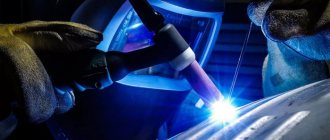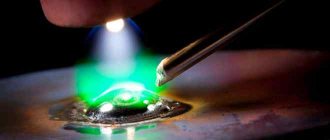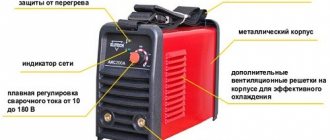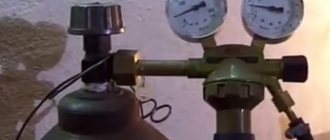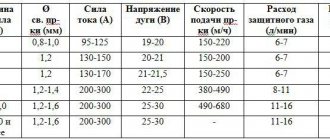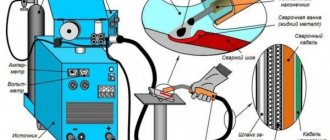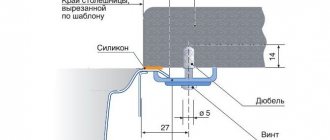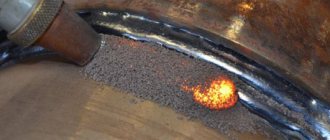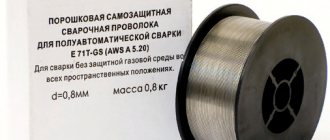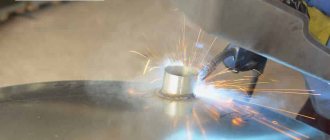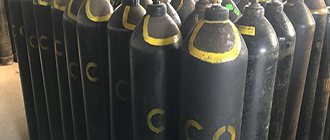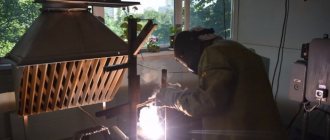Semi-automatic welding is understood as this type of application of an arc discharge when joining metals, in which the supply of wire used in welding is carried out automatically, while all the necessary installation and adjustment processes, as well as the movement of the welding torch itself, occurs only through the work of the operator himself . The basic principle of carbon dioxide arc welding is the displacement of ordinary air from the welding zone by a specially formed gas flow.
The environment formed as a result of such a gas flow is oxidizing for most metal components. In this regard, the possibility of oxidation of the metal components themselves cannot be ruled out, even though carbon dioxide protects the molten metal from exposure to air.
Features of welding in carbon dioxide
Due to the fact that the atmosphere around the metal is oxidizing in nature, you can often see that the carbon and alloying components of the metal burn out very quickly, resulting in the formation of pores in the weld, and the welding process itself can be characterized by an increase in metal spattering.
In order to minimize oxidation processes during the welding process, special types of wire are used that have been alloyed with silicon and manganese. These chemical elements are inherently good deoxidizers. Due to the introduction of deoxidizers, the oxidation of carbon is reduced, as well as the burnout of the constituent elements of the metal, as a result of which the number of pores in the weld is reduced, and the seam itself becomes of better quality in terms of mechanical parameters.
All welding is performed using current with reverse polarity, which ensures stable functioning of the arc. The result is high-quality edge fusion. If the welding process is carried out with a current of direct polarity, then metal fusing will occur, as well as its spattering.
Welding mode parameters
The welding modes used currently depend on a large number of factors, namely:
- equipment used;
- types of products to be joined by welding;
- the place where the entire welding process is carried out.
If we are talking about the welding process in relation to critical structures, for example, about welding pipes, then it is necessary to use a pulsed-arc welding method with a wire having a solid cross-section, supplied in carbon dioxide, in which a fine-droplet transfer of a controlled type is carried out in relation to the deposited metal. This method can be achieved through the use of a special microprocessor-type electronic module, which is installed in the inverter current source. Setting up such equipment can only be done by involving a specialist. In other cases, all modes can be selected based on the parameters that the metal has. You can track the most frequently used parameters based on the data in the table.
Welding parameters
Rules and nuances of semi-automatic pipe welding
The question of how to properly carry out semi-automatic pipe welding often worries young specialists and self-taught craftsmen. This procedure contains many nuances regarding the selection of consumables and process control.
So, as we found out above, depending on the specific feature, aggregates are:
- portable, mobile and stationary type of execution;
- stand-alone or built-in;
- with gas protection system, with flux, combined type or without protection;
- with steel electrode wire, flux-cored, aluminum, alloy or combined;
- with pushing, pulling or a combined method of feeding electrode wire;
- with a smooth, stepwise or stepwise method of regulating the intensity of wire feeding;
- designed for voltage 220 V or 380 V;
- with a natural or artificial method of cooling the burner;
- professional, semi-professional and household - depending on the purpose.
Regardless of the company and country of origin, all machines for semi-automatic pipe welding are characterized by a mechanical wire feeding method. An electrode with a diameter of 0.6 to 2.5 mm is fed to the tip through a flexible hose cable. In this case, the equipment is configured by the technician separately for each procedure.
The main elements of the device are:
- burner;
- hose cable;
- electrode feeding mechanism.
The feeding mechanism works by rotating rollers (one or two pairs). Their speed is adjusted in the settings of the main unit of the unit smoothly or stepwise depending on the structure of the device.
The power of the equipment directly depends on the weight of the cassette - from 1.5 to 50 kg. All of them can be either closed or open (there is also an apparatus for semi-automatic welding of open pipes, mounted on a trolley). A hose (welding sleeve) extends from the main unit to the holder or torch with a wire. It can be 1.5, 2.5 or 3 m in length. Equipment equipped with a gas protection system also has devices for supplying the corresponding substance.
The torch is the main tool of the welder. With its help, both the suturing process itself and protection (gas or flux, if available) are carried out. Manufacturers understand the importance of this device, so they are trying to do everything to improve it.
Different types of consumables have their own optimal mode of use. The main parameters for working with each of them are reflected in the table below.
| Type of wire | Wire diameter, mm | Wire feed speed, m/h | Current strength, A |
| Powder | 0,8; 0,9; 1,0; 1,2; 1,6; 2,0 | 120/720 | 120/630 |
| Aluminum | 0,8; 1,0; 1,2; 1,6 | 120/960 | 60/315 |
| Steel | 0,6; 0,8; 1,0; 1,2; 1,4; 1,6; 2,0; 2,5 | 120/720 | 60/630 |
It is necessary to perform semi-automatic pipe welding using gas protection only if the workplace is fully equipped. Required: a cylinder with a reducer, a gas supply speed regulator, a special heater (used when working with carbon dioxide).
Thus, semi-automatic welding of pipes using a protective gas system and flux-cored wire involves the following sequence of actions:
- thorough cleaning and degreasing of the working surface;
- setting up the gas system;
- performing a test seam on the rough surface to set the required unit settings;
- adjustment of voltage and current.
Semi-automatic coupling of pipes using gas protection significantly simplifies the work with the equipment. In this case, helium, argon, nitrogen or carbon dioxide can be used without changing the technology.
Rules for setting up and preparing equipment for the welding process
Preparing welding equipment for work can be divided into several stages:
- Preparation from a theoretical point of view . At this stage, it is necessary to familiarize yourself with the basic provisions of electrical safety in view of working with an electrical device of increased danger. In addition, at the stage of theoretical preparation, you should study the operating instructions for the welding machine itself, as well as the available recommendations for setting it up.
- Preparing the electrical network . Due to the fact that welding machines are very powerful in terms of current consumption, you should make sure that the safety circuit breakers are installed with the calculation of network overload from the use of the welding machine (the power of one machine must be at least 16 A, which will allow both to perform the necessary technological tasks and protect the electrical network from overloads). If possible, you should prepare a separate electrical line in which the wire cross-section will be at least 2.5 square millimeters. When connecting welding equipment, reduce the number and length of extension cords used to reduce the likelihood of a short circuit.
- Study of the device itself and the voltage with which it can work . Since there are two types of devices - those that operate from a 220 V and 380 V network - it should be understood that for the latter you will have to prepare a special bus or socket that will allow the device to be powered from a voltage of 380 V.
- Assembling the welding machine . It is recommended to carry out it only in a disconnected state in accordance with the rules specified in the operating instructions and in the assembly diagram. The connection of all parts must be secured using special clamps in order to eliminate the possibility of disconnection during operation. If you have to carry out welding at low temperatures, you should prepare a special reducer heater, which will ensure heating of the gas supply channels inside the reducer, which will prevent the gas supply from being cut off.
- Installing a cassette with welding wire . This manipulation is carried out only after the entire device is completely assembled, but before it is connected to the network. The end of the wire removed from the cassette must be carefully passed between the pressure and feed rollers and secured with a clamping mechanism. Careful preparation of the cassette is due to the fact that if the wire is damaged during welding, defects may occur in the seams.
- After the welding machine is fully assembled, it is connected to the electrical network, after which test welds are made . If assembly and adjustment are carried out in relation to a new device, then all test seams, including those to determine optimal settings, should be made on parts that simulate those to be welded in the future.
What is semi-automatic welding
The key to effective use of equipment is knowledge of its structure and operating technology. The main difference between a semi-automatic welding machine is that during the process the electrode wire is fed to the melting point automatically.
The design of such a device consists of:
- The main unit, which converts the mains electric current and is responsible for the uniform supply of electrode wire. This is where the device is set up before the procedure.
- Hose (welding sleeve).
- Burners with electrode wire.
- Conductive tip.
- Gas protection.
Large enterprises with a large volume of orders use stationary units for semi-automatic pipe welding. Such equipment provides high quality seams, saving time and energy.
All semi-automatic machines can be divided into several types:
- with cored wire;
- with flux-cored wire;
- with protection in the form of inert gases;
- universal.
Despite such diversity, they all do an excellent job of welding pipes from both non-ferrous and ferrous metals.
Depending on the method of electrode supply, machines for semi-automatic pipe welding can be divided into:
- portable – they are a small block that is easy to move;
- mobile – mounted on special wheels for more convenient transportation;
- stationary - firmly mounted on a stand in one room.
Based on the type of operation of the feeding device, the following are distinguished:
- pushing, when special rollers push the electrode to the welding site;
- pulling, when the feeding device is located in the handle itself and pulls the wire to the tip, which, as a rule, is located in the main block.
Preparing metal for welding
Preparing metal for welding is also divided into several stages:
- Determination of metal thickness . If the parts have a thickness in the range from 0.8 to 4 mm, then they should be welded without cutting the edges. Metal of this thickness is welded using pads of the same metal as the product itself, either on removable copper pads or on stainless steel pads. If the metal is thick (from 4 mm), then it can be welded by weight, and shims can be used only if necessary.
- Preparation of part forms based on drawing data . At this stage, you should study the drawing of the future product, mark all the necessary parts, cut them out using a grinder and clean off possible scale with an abrasive wheel. If the technological maps for the welding process stipulate a requirement for cutting the edge, it is also necessary to carry out such cutting.
- Select the most optimal welding method : when welding thin metal, a vertical arrangement of parts should be used, and the welding process itself should be carried out at an angle backwards, moving the torch from top to bottom. The seam with this arrangement is clearly visible. It must be remembered that deflection of the torch may lead to failure of the edges. When connecting corner parts, it is necessary to weld using the “boat” method. However, it should be taken into account that the output of wire in this case will increase by fifteen percent compared to the technology when the joining is carried out in the lower position.
Equipment for semi-automatic pipe welding
Semi-automatic welding can be performed on pipes of different types of steel - from standard to stainless steel. The advantage of this method is that the electrode wire is supplied continuously throughout the entire process. This relieves the technician from the need to constantly change electrodes, saving his time and energy costs.
The most common units are those equipped with a protective gas system – MIG/MAG. Unlike semi-automatic machines with flux protection, they can be used to work both in a vertical and horizontal plane, and it is much easier to maintain the aesthetics of the seam.
Welding technology
Recommendations that should be relied upon when carrying out the welding process are contained in various normative documents of standardization type: GOST, STO, KTN, etc. The main list of technical requirements is contained in: GOST 14771-76, GOST 18130-79.
Among the main features of the welding process, it should be remembered that:
- lap joints with a metal thickness of 1.5 mm or less are made only on copper or steel pads with one pass;
- Horizontal seams should only be made using a “forward angle” seam without performing oscillatory movements on the torch. If you have to weld metal with a thickness of more than 6 mm, then it is necessary to make several passes;
- welding of parts whose thickness is less than 3 mm is carried out only at a right angle of the torch in relation to the parts being welded, without cutting the edges;
- if the thickness of the parts is more than 3 mm , then cutting the upper edge in a horizontal position is permissible. The torch must be tilted relative to the upper element being welded at an angle of about seventy degrees.
Advantages and disadvantages
Among the advantages of semi-automatic welding in a carbon dioxide environment, the following should be considered:
- obtaining a high-quality welded joint , which can also be obtained for thin-walled structures;
- high productivity compared to manual arc, gas and other types of welding;
- can be performed in any spatial arrangement of parts (from the lowest to the ceiling);
- the minimum zone in which thermal influence occurs;
- Deformations and stresses of the metal in this case are insignificant;
- it is possible to completely automate the process.
If we talk about the disadvantages, then these are:
- if welding is carried out outdoors or in a draft, then a violation of gas protection becomes more likely;
- electrode metal spatters during welding;
- in high power modes, there is a need for water cooling of equipment due to the likelihood of overheating.
